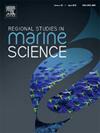Evaluation of metals in surface sediments from shrimp farming areas in the estuarine region of the Baixo São Francisco, in Northeastern Brazil
IF 2.1
4区 环境科学与生态学
Q3 ECOLOGY
引用次数: 0
Abstract
This study investigated surface sediments from shrimp farms in the Baixo São Francisco region of Northeastern Brazil to assess the contamination levels of eight trace metals: Fe, Mn, Cr, Zn, Pb, Cu, Ni, and Cd. The concentrations of these metals ranged from 0.41 to 3.32 µg g−1 across various sampling points, with the highest levels detected in fine silt-dominated sediments. Employing the enrichment factor (EF), geoaccumulation index (Igeo), and potential ecological risk index (PERI), the samples were categorized into three groups. Group 1 samples originated from natural sources (Cd and Fe), group 2 indicated signs of human activities (Cr, Cu, Ni, Pb and Zn), and group 3 exhibited the lowest metal concentrations. The EF values indicated minimal to moderate enrichment, particularly for Cu and Zn, whereas Cd and Cr were not enriched. Ecological risk assessment revealed that all sites displayed low ecological risk, with PERI values ranging between 0.31 and 19.9. These findings highlight the potential influence of human activities on sediment quality in shrimp farming areas and emphasize the need for ongoing environmental monitoring and management practices to mitigate contamination risks.
求助全文
约1分钟内获得全文
求助全文
来源期刊

Regional Studies in Marine Science
Agricultural and Biological Sciences-Ecology, Evolution, Behavior and Systematics
CiteScore
3.90
自引率
4.80%
发文量
336
审稿时长
69 days
期刊介绍:
REGIONAL STUDIES IN MARINE SCIENCE will publish scientifically sound papers on regional aspects of maritime and marine resources in estuaries, coastal zones, continental shelf, the seas and oceans.
 求助内容:
求助内容: 应助结果提醒方式:
应助结果提醒方式:


